Alaska Economic Trends
Alaska Economic Trends is a monthly magazine that covers a range of economic topics.
Sign up for a free electronic subscription. 
Sign up for a paid print subscription.
Alaska Economic Trends are searchable from 1961 to the present using the Trends search page. The search can include any combination of the following: Key Words, Date Range, Author, Category
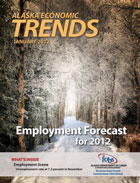
Alaska gained jobs for the second consecutive year in 2011 after ripple effects from the national and global recession ended the state's 21-year growth streak in 2009. More growth is forecasted for Alaska in 2012 - a modest increase of 1.2 percent, or 3,900 jobs - but neither the global nor U.S. economies are on clear recovery paths yet, and that will dampen the Alaska outlook in the coming year.
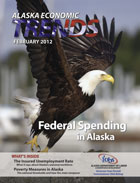
The federal government has been Alaska's largest employer since the days before statehood, generating approximately a third of all jobs in the state. That means Alaska has a lot to lose as proposed federal budget cuts over the next 10 years could top $1.5 trillion - the largest spending cuts since the end of World War II.
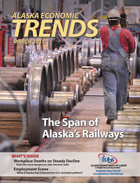
Over three-quarters of a million people rode the Alaska rails in 2011, whether for breathtaking views from the trestles or to hop off the train at a remote flagstop for a hike to the family homestead. Alaska has just two operating railroads now, but its rich history of rail lines from Nome to Prince of Wales Island helped put the state on track to greater economic development and formation of its major population centers.
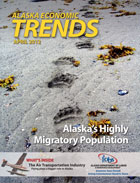
Alaska has one of the highest rates of population turnover in the nation - there are always large numbers of people moving in and out, regardless of whether the overall population is growing or shrinking. Depending on the year and data source, between 5 and 7 percent of Alaska's population enters or leaves the state each year. These large flows in and out, or 'gross migration,' tend to be fairly stable and predictable.
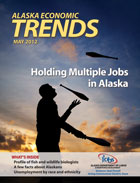
Roughly 11 percent of Alaskans held more than one job at a time in 2010. For some, moonlighting is a one-time way to pay down debt or save for a high-ticket item. For others, seasonal employment offers a second-income opportunity that comes once a year. Others work two or more jobs as a year-in, year-out way of life - sometimes by choice but often by circumstance.
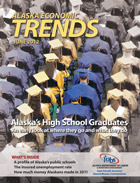
An early look at where they go and what they do What happens to the thousands of Alaska high school students after they leave school - whether as graduates or otherwise - is not just an educational question. It's also an economic issue for the state, given that much of Alaska's workforce will come from that pool of potential workers
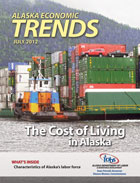
Anchorage's inflation rate rose from 1.8 percent to 3.2 percent in 2011 - its second-highest increase in the past decade. Energy prices explain much of the difference. They rose 10.8 percent in 2011 and have registered even bigger increases three times over the past 10 years.
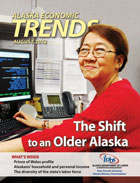
With a median age of 33.8 years, Alaska is the third-youngest state in the nation after Utah and Texas. Alaska is young in part because it has a higher-than average birth rate and it tends to attract young workers - but more importantly, it's home to relatively few people age 65 and older. In 2010, that age group was just 7.7 percent of Alaska's population, the smallest share of any state.
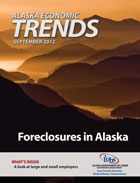
The housing bubble and subsequent foreclosure crisis in the United States continues to hamper regional housing markets and broad economic recovery, but Alaska was one of the healthiest states in terms of mortgage delinquencies throughout the national collapse, and the state's housing market remains relatively stable. Though Alaska's housing market has cooled since 2006, the state had the third-lowest delinquency rate in the U.S. in the first quarter of 2012.
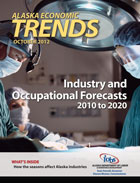
Alaska is expected to add 38,749 jobs between 2010 and 2020, an increase of 12 percent. Health care and social assistance, which will benfit from the needs of an aging population, is projected to grow by about 31 percent by far the highest of any industry. The second-highest growth will be in mining, minus oil and gas, at 19 percent.
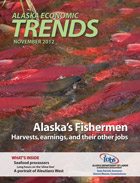
Alaska has long had one of the most valuable commercial fishing industries in the nation. Four of the top 10 ports for landings by volume and six of the top 10 ports for value are in the state. More than half of commercially captured U.S. seafood is caught in Alaska.
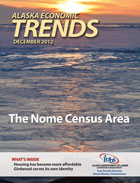
The Nome Census Area has fewer than 10,000 people and less than one person per square mile, but its presence is much larger. People are often familiar with Nome as the finish line of the world-famous Iditarod sled dog race, and recently as the site of a Discovery Channel reality show called 'Bering Sea Gold.' It's also a stop along the well-known Iron Dog snowmachine race. In many ways, Nome reflects Alaska's grandeur and many recreational opportunities.
